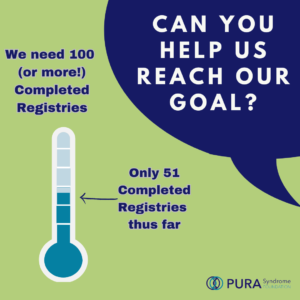Patient Registry Update
 Parents and Caregivers – We Need Your Help to complete at least 100 Patient Registries! Dr. Hunt gave an update at our June Conference as to where we are at with our Global Patient Registry. We currently have 51 completed registries with 37 more started but incomplete. We cannot stress the importance of taking the time to do this in order to offer researchers more insight into PURA Syndrome!
Parents and Caregivers – We Need Your Help to complete at least 100 Patient Registries! Dr. Hunt gave an update at our June Conference as to where we are at with our Global Patient Registry. We currently have 51 completed registries with 37 more started but incomplete. We cannot stress the importance of taking the time to do this in order to offer researchers more insight into PURA Syndrome!
This year we have added a few tools to help our families complete their registries:
- One-on-one appointments with our Research Nurse Tessy or PURA Aunt Lyn who are both available in hour increments to help you along as you fill in the Registry.
- A checklist of items that you will need to gather beforehand in order to complete the registry.
For more information and to register, please visit: www.purasyndrome.org/ registry
Biobank Agreement Finalized
In July, the PURA Syndrome Foundation signed an agreement with Helmholtz Zentrum München in Germany to provide grant funding that will help finalize administrative work and prepare for the launch of the Biobank. It will serve as a global collection and distribution point for PURA research. The PURA Biobank can then act as a resource for researchers across the globe that wish to study the condition. Samples will be used for research with the long-term goal to understand and develop treatment strategies for PURA syndrome or related disorders that include genomic deletion or duplication of the PURA gene.
We are excited to keep moving this key part of our research pillar forward and will let our PURA Community know when it will be ready to accept samples. Please note – in order to submit samples to the Biobank you will need to have completed the PURA Patient Registry. For more information, visit our website at: https://purasyndrome.org/research/biobank/
Published PURA Research

At our PURA Syndrome conference, Dr. Robert Janowski presented about this new publication in the eLife journal. To summarize the paper:
- Knowing only the genetic variation does not really tell you which function is lost in a patient. This study investigated 6 different genetic variants and asked if they all cause the same defects on a molecular and cellular level.
- To date, it is unclear why so many different genetic variations all result in the full disease spectrum. In other disorders such as Rett syndrome, many more patients with milder symptoms are known. Dr. Janowski found a likely answer to this PURA riddle
- One of the highlights of this study is the first snapshot of human PURA at atomic resolution.
To read the full publication, go to: https://elifesciences.org/reviewed-preprints/93561

There’s a new scientific review paper published in the journal Clinical Genetics which takes a close look at patients with different genetic changes that affect the PURA gene, located at chromosome 5q31. To summarize the paper:
- The publication illustrates three specific groups: 1) patients with a mutation in the PURA gene (called PURA-SNP in the paper, or single nucleotide polymorphisms/variants); 2) patients with a deletion at chromosome location 5q31 where the PURA gene is also affected or deleted (called 5q31+PURA); and 3) patients with a deletion on the chromosome at location 5q31 where the PURA gene is not part of the chromosomal deletion (5q31-PURA, where the PURA gene is intact and thus is not technically defined as PURA Syndrome).
- The review found that all three groups had symptoms that include hypotonia, feeding difficulties, and physical features that are commonly seen in PURA Syndrome patients.
- The primary difference is that patents in the 5q31-PURA were not as affected by epilepsy, and were able to reach certain developmental milestones more than those without the PURA gene.
- These results show that among these three groups, PURA is a significant contributor to developmental delay and epilepsy in the PURA population.
To read the full publication, go to: https://onlinelibrary.wiley.com/doi/abs/10.1111/cge.14581

Another scientific article has been published in the journal of Neurology Genetics showing evidence of the first identified inherited case of PURA syndrome.
- This publication describes a mother-daughter pair who have a mild case of PURA syndrome, where the primary symptoms are dysarthria (slurred speech), and borderline intellectual disability.
- Other symptoms are discussed given a thorough evaluation of the patients, and the study may open screening and genetic counseling to patients who exhibit these symptoms.
To read the full publication, go to: https://www.neurology.org/doi/10.1212/NXG.0000000000200181

A study published in the journal Biochimica et Biophysica Acta (BBA) – Molecular Basis of Disease illustrates a potential link between PURA syndrome, and a condition called hypoglycorrhachia, which occurs when a patient has low levels of glucose in their cerebrospinal fluid.
- The study found a potential link between the PURA protein, and GLUT1 which regulates glucose movement across the blood-brain barrier, where GLUT1 deficiency syndrome has several symptoms similar to PURA syndrome and includes hypoglycorrhachia.
- The cell-based experiments in this paper demonstrated that PURA protein enhanced glucose uptake in cells, PURA and GLUT1 co-localize within the cells both visually and physically, providing a molecular lead to further explore PURA’s role in glucose regulation in the body. To read the full publication, go to: https://www.sciencedirect.com/science/article/abs/pii/S0925443924002503?via%3Dihub
